DeWalt DC528 Handleiding
Bekijk gratis de handleiding van DeWalt DC528 (7 pagina’s), behorend tot de categorie Zaklamp. Deze gids werd als nuttig beoordeeld door 72 mensen en kreeg gemiddeld 4.5 sterren uit 36.5 reviews. Heb je een vraag over DeWalt DC528 of wil je andere gebruikers van dit product iets vragen? Stel een vraag
Pagina 1/7

IF YOU HAVE ANY QUESTIONS OR COMMENTS ABOUT THIS OR ANY DEWALT TOOL,
CALL US TOLL FREE AT: 1-800-4-DEWALT (1-800-433-9258)
General Safety Rules
WARNING! Read all instructions. Failure to follow all instructions listed below
may result in electric shock, fire and/or serious injury. The term “power tool” in all
of the warnings listed below refers to your mains-operated (corded) power tool or bat-
tery-operated (cordless) power tool.
SAVE THESE INSTRUCTIONS
1) WORK AREA SAFETY
a) Keep work area clean and well lit. Cluttered or dark areas invite accidents.
b) Do not operate power tools in explosive atmospheres, such as in the presence of
flammable liquids, gases or dust. Power tools create sparks which may ignite the dust
or fumes.
c) Keep children and bystanders away while operating a power tool. Distractions can
cause you to lose control
2) ELECTRICAL SAFETY
a) Power tool plugs must match the outlet. Never modify the plug in any way. Do not
use any adapter plugs with earthed (grounded) power tools. Unmodified plugs and
matching outlets will reduce risk of electric shock
b) Avoid body contact with earthed or grounded surfaces such as pipes, radiators,
ranges and refrigerators. There is an increased risk of electric shock if your body is
earthed or grounded.
c) Do not expose power tools to rain or wet conditions. Water entering a power tool will
increase the risk of electric shock
d) Do not abuse the cord. Never use the cord for carrying, pulling or unplugging the
power tool. Keep cord away from heat, oil, sharp edges or moving parts. Damaged
or entangled cords increase the risk of electric shock. Replace or repair damaged cords.
Make sure your extension cord is in good condition. Use only 3-wire extension cords that
have 3-prong grounding-type plugs and 3-pole receptacles that accept the tool’s plug.
e) When operating a power tool outdoors, use an extension cord suitable for outdoor
use. Use of a cord suitable for outdoor use reduces the risk of electric shock. When using
an extension cord, be sure to use one heavy enough to carry the current your product
will draw. An undersized cord will cause a drop in line voltage resulting in loss of power
and overheating. The following table shows the correct size to use depending on cord
length and nameplate ampere rating. If in doubt, use the next heavier gage. The small-
er the gage number, the heavier the cord.
Recommended Minimum Wire Size for Extension Cords
Total Length of Cord
25 ft. 50 ft. 75 ft. 100 ft. 125 ft. 150 ft. 175 ft.
7.6 m 15.2 m 22.9 m 30.5 m 38.1 m 45.7 m 53.3 m
Wire Size AWG
18 18 16 16 14 14 12
3) PERSONAL SAFETY
a) Stay alert, watch what you are doing and use common sense when operating a
power tool. Do not use a power tool while you are tired or under the influence of
drugs, alcohol or medication. A moment of inattention while operating power tools may
result in serious personal injury.
b) Use safety equipment. Always wear eye protection. Safety equipment such as dust
mask, non-skid safety shoes, hard hat, or hearing protection used for appropriate condi-
tions will reduce personal injuries.
c) Avoid accidental starting. Ensure the switch is in the off-position before plugging
in. Carrying power tools with your finger on the switch or plugging in power tools that
have the switch on invites accidents.
d) Remove any adjusting key or wrench before turning the power tool on. A wrench
or a key left attached to a rotating part of the power tool may result in personal injury.
e) Do not overreach. Keep proper footing and balance at all times. This enables better
control of the power tool in unexpected situations.
f) Dress properly. Do not wear loose clothing or jewellery. Keep your hair, clothing
and gloves away from moving parts. Loose clothes, jewellery or long hair can be
caught in moving parts. Air vents often cover moving parts and should also be avoided.
g) If devices are provided for the connection of dust extraction and collection facili-
ties, ensure these are connected and properly used. Use of these devices can
reduce dust-related hazards.
4) POWER TOOL USE AND CARE
a) Do not force the power tool. Use the correct power tool for your application. The
correct power tool will do the job better and safer at the rate for which it was designed.
b) Do not use the power tool if the switch does not turn it on and off. Any power tool
that cannot be controlled with the switch is dangerous and must be repaired.
c) Disconnect the plug from the power source and/or the battery pack from the power
tool before making any adjustments, changing accessories, or storing power
tools. Such preventive safety measures reduce the risk of starting the power tool acci-
dentally.
d) Store idle power tools out of the reach of children and do not allow persons unfa-
miliar with the power tool or these instructions to operate the power tool. Power
tools are dangerous in the hands of untrained users.
INSTRUCTION MANUAL
GUIDE D'UTILISATION
MANUAL DE INSTRUCCIONES
DC527 18 Volt Fluorescent Area Light
DC528 14.4/12 Volt Fluorescent Area Light
Lampe de pièce fluorescente DC527 de 18 V
Lampe de pièce fluorescente DC528 de 14,4/12 V
Luz zonal fluorescente de 18 voltios DC527
Luz zonal fluorescente de 14,4/12 voltios DC528
INSTRUCTIVO DE OPERACIÓN, CENTROS DE SERVICIO Y
PÓLIZA DE GARANTÍA. ADVERTENCIA: LÉASE ESTE
INSTRUCTIVO ANTES DE USAR EL PRODUCTO.
DEWALT Industrial Tool Co., 701 East Joppa Road, Baltimore, MD 21286
(JUL05) Form No. 636041-00 DC527, DC528 Copyright © 2005 DEWALT
The following are trademarks for one or more DEWALT power tools: the yellow and black color scheme; the “D” shaped
air intake grill; the array of pyramids on the handgrip; the kit box configuration; and the array of lozenge-shaped humps
on the surface of the tool.
e) Maintain power tools. Check for misalignment or binding of moving parts, break-
age of parts and any other condition that may affect the power tools operation. If
damaged, have the power tool repaired before use. Many accidents are caused by
poorly maintained power tools.
f) Keep cutting tools sharp and clean. Properly maintained cutting tools with sharp cut-
ting edges are less likely to bind and are easier to control.
g) Use the power tool, accessories and tool bits etc., in accordance with these
instructions and in the manner intended for the particular type of power tool, tak-
ing into account the working conditions and the work to be performed. Use of the
power tool for operations different from those intended could result in a hazardous situ-
ation.
5) BATTERY TOOL USE AND CARE
a) Ensure the switch is in the off position before inserting battery pack. Inserting the
battery pack into power tools that have the switch on invites accidents.
b) Recharge only with the charger specified by the manufacturer. A charger that is suit-
able for one type of battery pack may create a risk of fire when used with another battery
pack.
c) Use power tools only with specifically designated battery packs. Use of any other
battery packs may create a risk of injury and fire.
d) When battery pack is not in use, keep it away from other metal objects like paper
clips, coins, keys, nails, screws, or other small metal objects that can make a con-
nection from one terminal to another. Shorting the battery terminals together may
cause burns or a fire.
e) Under abusive conditions, liquid may be ejected from the battery, avoid contact. If
contact accidentally occurs, flush with water. If liquid contacts eyes, additionally
seek medical help. Liquid ejected from the battery may cause irritation or burns.
6) SERVICE
a) Have your power tool serviced by a qualified repair person using only identical
replacement parts. This will ensure that the safety of the power tool is maintained.
Safety Rules for Fluorescent Area Lights
WARNING: Burn hazard. Do not operate flashlight or charger near flammable liquids or in
gaseous or explosive atmospheres. Internal sparks may ignite fumes causing personal injury.
WARNING: Shock Hazard. Remove battery pack before replacing the fluorescent tube.
WARNING: Lens and fluorescent tube become hot during use.
• During or immediately after use, don’t lay area light flat on lens surface.
• Don’t touch lens surface when tube is lit or immediately after use.
• Handle light with care around any flammable surface.
• If fluorescent tube has been lit, let it cool for several minutes before changing tube.
• Vision may be impaired when looking directly into fluorescent light.
• Do not expose light or charger to wet or damp areas. Do not expose light or charger to rain
or snow.
• Do not wash light or charger with water or allow water to get inside light or charger. Do not
submerge light in water at any time.
• While light is in use, do not cover with cloth or other flammable materials due to increased
risk of fire.
• Do not operate without lens cover assembly attached.
CAUTION: When not in use, place tool on its side on a stable surface where it will not
cause a tripping or falling hazard. Some tools with large battery packs will stand upright on
the battery pack but may be easily knocked over.
• The label on your tool may include the following symbols.
V ..........volts A ................amperes
Hz ........hertz W ..............watts
min ........minutes ..............alternating current
......direct current no ..............no load speed
........Class II Construction …/min ........revolutions or reciprocation per minute
........earthing terminal ..............safety alert symbol
Important Safety Instructions for Battery Packs
The DC527 uses an 18 Volt D WALT battery pack. The DC528 can use a 12 Volt or 14.4 VoltE
DEWALT battery pack. When ordering replacement battery packs, be sure to include catalog
number and voltage: Extended Run-Time battery packs deliver more run-time than standard
battery packs. Consult the chart at the end of this manual for compatibility of chargers and
battery packs.
NOTE: Your tool will accept either standard or Extended Run Time battery packs. However, be
sure to select proper voltage. Batteries slowly lose their charge when they are not on the
charger, the best place to keep your battery is on the charger at all times.
The battery pack is not fully charged out of the carton. Before using the battery pack and
charger, read the safety instructions below. Then follow charging procedures outlined.
READ ALL INSTRUCTIONS
• Do not incinerate the battery pack even if it is severely damaged or is completely
worn out. The battery pack can explode in a fire.
• A small leakage of liquid from the battery pack cells may occur under extreme usage
or temperature conditions. This does not indicate a failure. However, if the outer seal is
broken and this leakage gets on your skin:
a. Wash quickly with soap and water.
b. Neutralize with a mild acid such as lemon juice or vinegar.
c. If battery liquid gets into your eyes, flush them with clean water for a minimum of 10 min-
utes and seek immediate medical attention. (Medical note: The liquid is 25-35% solu-
tion of potassium hydroxide.)
• Charge the battery packs only in D EWALT chargers.
•DO NOT splash or immerse in water or other liquids.
• Do not store or use the tool and battery pack in locations where the temperature may
reach or exceed 105°F (such as outside sheds or metal buildings in summer).
DANGER: Electrocution hazard. Never attempt to open the battery pack for any reason.
If battery pack case is cracked or damaged, do not insert into charger. Electric shock or
electrocution may result. Damaged battery packs should be returned to service center for
recycling.
NOTE: Battery storage and carrying caps are provided for use whenever the
battery is out of the tool or charger. Remove cap before placing battery in
charger or tool.
WARNING: Fire hazard. Do not store or carry battery so that metal
objects can contact exposed battery terminals. For example, do not place
battery in aprons, pockets, tool boxes, product kit boxes, drawers, etc., with loose
nails, screws, keys, etc. without battery cap. Transporting batteries can possibly cause
fires if the battery terminals inadvertently come in contact with conductive materials
such as keys, coins, hand tools and the like. The US Department of Transportation
Hazardous Material Regulations (HMR) actually prohibit transporting batteries in commerce or
on airplanes (i.e., packed in suitcases and carry-on luggage) UNLESS they are properly
protected from short circuits. So when transporting individual batteries, make sure that the
battery terminals are protected and well insulated from materials that could contact them and
cause a short circuit.
The RBRC™ Seal
The RBRC™ (Rechargeable Battery Recycling Corporation) Seal on the
nickel-cadmium battery (or battery pack) indicates that the costs to recycle the
battery (or battery pack) at the end of its useful life have already been paid by
DEWALT. In some areas, it is illegal to place spent nickel-cadmium batteries in
the trash or municipal solid waste stream and the RBRC program provides an
environmentally conscious alternative.
RBRC™ in cooperation with DEWALT and other battery users, has established programs in
the United States to facilitate the collection of spent nickel-cadmium batteries. Help protect our
environment and conserve natural resources by returning the spent nickel-cadmium battery to
an authorized DEWALT service center or to your local retailer for recycling. You may also
contact your local recycling center for information on where to drop off the spent battery.
RBRC™ is a registered trademark of the Rechargeable Battery Recycling Corporation.
Important Safety Instructions for Battery Chargers
SAVE THESE INSTRUCTIONS: This manual contains important safety instructions for battery
chargers.
• Before using charger, read all instructions and cautionary markings on charger, battery
pack, and product using battery pack.
DANGER: Electrocution hazard. 120 volts are present at charging terminals. Do not probe
with conductive objects. Electric shock or electrocution may result.
WARNING: Shock hazard. Do not allow any liquid to get inside charger. Electric shock may
result.
CAUTION: Burn hazard. To reduce the risk of injury, charge only DEWALT nickel-cadmium
rechargeable batteries. Other types of batteries may burst causing personal injury and damage.
CAUTION: Under certain conditions, with the charger plugged in to the power supply, the
exposed charging contacts inside the charger can be shorted by foreign material. Foreign
materials of a conductive nature such as, but not limited to, steel wool, aluminum foil, or any
buildup of metallic particles should be kept away from charger cavities. Always unplug the
charger from the power supply when there is no battery pack in the cavity. Unplug charger
before attempting to clean.
If you have questions or comments, contact us.
Pour toute question ou tout commentaire, nous contacter.
Si tiene dudas o comentarios, contáctenos.
1-800-4-DEWALT • www.dewalt.com

• DO NOT attempt to charge the battery pack with any chargers other than the ones in
this manual. The charger and battery pack are specifically designed to work together.
•These chargers are not intended for any uses other than charging DEWALT recharge-
able batteries. Any other uses may result in risk of fire, electric shock or electrocution.
•Do not expose charger to rain or snow.
•Pull by plug rather than cord when disconnecting charger. This will reduce risk of
damage to electric plug and cord.
•Make sure that cord is located so that it will not be stepped on, tripped over, or
otherwise subjected to damage or stress.
• Do not use an extension cord unless it is absolutely necessary. Use of improper
extension cord could result in risk of fire, electric shock, or electrocution.
•An extension cord must have adequate wire size (AWG or American Wire Gauge) for
safety. The smaller the gauge number of the wire, the greater the capacity of the cable, that
is 16 gauge has more capacity than 18 gauge. When using more than one extension to
make up the total length, be sure each individual extension contains at least the minimum
wire size.
•Do not place any object on top of charger or place the charger on a soft surface that
might block the ventilation slots and result in excessive internal heat. Place the
charger in a position away from any heat source. The charger is ventilated through slots in
the top and the bottom of the housing.
•Do not operate charger with damaged cord or plug — have them replaced immediately.
•Do not operate charger if it has received a sharp blow, been dropped, or otherwise
damaged in any way. Take it to an authorized service center.
•Do not disassemble charger; take it to an authorized service center when service or
repair is required. Incorrect reassembly may result in a risk of electric shock, electrocution
or fire.
•Disconnect the charger from the outlet before attempting any cleaning. This will
reduce the risk of electric shock. Removing the battery pack will not reduce this risk.
•NEVER attempt to connect 2 chargers together.
•The charger is designed to operate on standard household electrical power
(120 Volts). Do not attempt to use it on any other voltage. This does not apply to the
vehicular charger.
SAVE THESE INSTRUCTIONS
FOR FUTURE USE
Chargers
Your tool uses a D WALT charger. Your battery can be charged in D WALT 1 Hour Chargers,E E
15 Minute Chargers or Vehicular 12 Volt Charger. Be sure to read all safety instructions before
using your charger. Consult the chart on the back cover of this manual for compatibility of
chargers and battery packs.
Charging Procedure
DANGER: Electrocution hazard. 120 volts are present at charging terminals. Do not probe
with conductive objects. Electric shock or electrocution may result.
1. Plug the charger into an appropriate outlet.
2. Insert the battery pack into the charger. The red (charging) light will blink continuously
indicating that the charging process has started.
3. The completion of charge will be indicated by the red light remaining ON continuously. The
pack is fully charged and may be used at this time or left in the charger.
Indicator Light Operation
Charge Indicators
Some chargers are designed to detect certain problems that can arise with battery packs.
Problems are indicated by the red light flashing at a fast rate. If this occurs, re-insert battery
pack into the charger. If the problem persists, try a different battery pack to determine if the
charger is OK. If the new pack charges correctly, then the original pack is defective and
should be returned to a service center or other collection site for recycling. If the new bat-
tery pack elicits the same trouble indication as the original, have the charger tested at an
authorized service center.
HOT/COLD PACK DELAY
Some chargers have a Hot/Cold Pack Delay feature: when the charger detects a battery that
is hot, it automatically starts a Hot Pack Delay, suspending charging until the battery has
cooled. After the battery has cooled, the charger automatically switches to the Pack Charging
mode. This feature ensures maximum battery life. The red light flashes long, then short while
in the Hot Pack Delay mode.
PROBLEM POWER LINE
Some chargers have a Problem Power Line indicator. When the charger is used with some
portable power sources such as generators or sources that convert DC to AC, the charger may
temporarily suspend operation, flashing the red light with two fast blinks followed by a
pause. This indicates the power source is out of limits.
LEAVING THE BATTERY PACK IN THE CHARGER
The charger and battery pack can be left connected with the red light glowing indefinitely. The
charger will keep the battery pack fresh and fully charged.
NOTE: Abattery pack will slowly lose its charge when kept out of the charger. If the battery
pack has not been kept on maintenance charge, it may need to be recharged before use. A
battery pack may also slowly lose its charge if left in a charger that is not plugged into an
appropriate AC source.
WEAK BATTERY PACKS: Chargers can also detect a weak battery. Such batteries are still
usable but should not be expected to perform as much work. In such cases, about 10 seconds
after battery insertion, the charger will beep rapidly 8 times to indicate a weak battery condi-
tion. The charger will then go on to charge the battery to the highest capacity possible.
Important Charging Notes
1. Longest life and best performance can be obtained if the battery pack is charged when the
air temperature is between 65°F and 75°F (18°- 24°C). DO NOT charge the battery pack
in an air temperature below +40°F (+4.5°C), or above +105°F (+40.5°C). This is important
and will prevent serious damage to the battery pack.
2. The charger and battery pack may become warm to touch while charging. This is a nor-
mal condition, and does not indicate a problem. To facilitate the cooling of the battery pack
after use, avoid placing the charger or battery pack in a warm environment such as in a
metal shed, or an uninsulated trailer.
3. If the battery pack does not charge properly:
a. Check current at receptacle by plugging in a lamp or other appliance
b. Check to see if receptacle is connected to a light switch which turns power off when you
turn out the lights.
c. Move charger and battery pack to a location where the surrounding air temperature is
approximately 65°F - 75°F (18°- 24°C).
d. If charging problems persist, take the tool, battery pack and charger to your local
service center.
4. The battery pack should be recharged when it fails to produce sufficient power on jobs
which were easily done previously. DO NOT CONTINUE to use under these conditions.
Follow the charging procedure. You may also charge a partially used pack whenever you
desire with no adverse affect on the battery pack.
5. Under certain conditions, with the charger plugged into the power supply, the exposed
charging contacts inside the charger can be shorted by foreign material. Foreign materials
of a conductive nature such as, but not limited to, steel wool, aluminum foil, or any buildup
of metallic particles should be kept away from charger cavities. Always unplug the charg-
er from the power supply when there is no battery pack in the cavity. Unplug charger before
attempting to clean.
6. Do not freeze or immerse charger in water or any other liquid.
WARNING: Don’t allow any liquid to get inside charger. Electric shock may result.
CAUTION: Never attempt to open the battery pack for any reason. If the plastic housing of
the battery pack breaks or cracks, return to a service center for recycling.
Components (Fig. 1)
A. Battery pack E. Base
B. Release buttons F. Lens
C. Switch G. Hook
D. Lens cover assembly
OPERATION
Installing and Removing the Battery Pack (Fig. 2)
NOTE: Make sure your battery pack is fully charged.
To insert the battery pack (A) into your fluorescent area light, slide it into the end of the light
until it snaps into place. To remove the battery pack, depress the release buttons (B) and
withdraw the battery pack.
FIG. 1
FIG. 2
FIG. 5
FIG. 4
Switch (Fig. 1)
To turn the light on, slide the switch (C) forward. To turn it off, slide the switch back.
Replacing the Fluorescent Tube (Fig. 3, 4)
CAUTION: Disconnect battery pack from tool before replacing the fluorescent tube.
Such preventative safety measures reduce the risk of personal injury.
CAUTION: Burn hazard. Lens or fluorescent tube may be hot immediately after use.
CAUTION: Vision may be impaired when looking directly into fluorescent light.
CAUTION: If replacing a broken tube, protect your hands before attempting to remove the
tube. Do not remove any pieces of broken glass or tube from the socket area with bare hands,
or personal injury may occur.
NOTE: Use only DEWALT DC5273 13W tube.
1. With one hand on the lens cover assembly (D) and the other hand on the base (E), slowly
rotate the cover counterclockwise from its original position.
2. Carefully lift the lens cover assembly up and over the tube. Set aside.
3. Carefully remove the tube from the socket by gently pulling up from the base. Check
to ensure the socket and the area around the socket is free of dirt, dust and other
contaminants.
NOTE: Aclear, rubber end cap is mounted inside the top portion of the lens cover
assembly This endcap must align with the top of the fluorescent tube in order for the
lens cover assembly to fit properly onto the handle. The rubber end cap should be in the
correct position when lens cover assembly is removed to allow new tube to fit.
4. Once the new tube is in place, align the slots (H) at the bottom of the lens cover assembly
with the slots (I) at the top of the base.
5. Push the lens cover assembly down then rotate it clockwise to lock into place.
Hook (Fig. 5)
CAUTION: When hook is in use, do not shake light. Personal injury or property damage may
occur.
CAUTION: When light is hung by the hook, do not shake the light or object that it is hanging
from. Do not hang the light from any electrical wires or anything that it is not secure. Personal
injury or property damage may occur.
CAUTION: Only use the hook for hanging the area light. The hook is not intended to
support additional weight. Do not attach or hang anything additional to the light or risk of
breakage may occur.
CAUTION: Do not reach with the hook or use the hook to support your weight in any
situation.
The built-in hook (G) telescopes out of the lens cover assembly (D). This hook locks into place
in the down position and when fully extended, as shown in Figure 5. The hook rotates
360 degrees and can be locked at 45-degree positions when fully extended.
MAINTENANCE
• MAINTAIN TOOL WITH CARE. Keep fluorescent tube area clean for best and safest
performance.
• Do not attempt to repair the area light. To assure product safety and reliability, repairs,
maintenance, and adjustments should be performed by authorized D EWALT service
centers.
Cleaning
Use only mild soap and a damp cloth to clean the tool. Many household cleaners contain
chemicals which could seriously damage plastic. Also, do not use gasoline, turpentine,
lacquer or paint thinner, dry cleaning fluids or similar products. Never let any liquid get
inside the tool; never immerse any part of the tool into a liquid.
Accessories
A replacement fluorescent tube is available at extra cost at your local DEWALT service center.
Recommended accessories for use with your tool are available at extra cost from your local
dealer or authorized service center. If you need assistance in locating any accessory for your
tool, please contact DEWALT Industrial Tool Co., 701 East Joppa Road, Baltimore, MD 21286,
call 1-800-4-DEWALT (1-800-433-9258) or visit our website www.dewalt.com.
CAUTION: The use of any other accessory not recommended for use with this fluorescent
light could be hazardous.
Repairs
To assure product SAFETY and RELIABILITY, repairs, maintenance and adjustment (including
brush inspection and replacement) should be performed by a DEWALT factory service center,
a DEWALT authorized service center or other qualified service personnel. Always use identical
replacement parts.
Three Year Limited Warranty
DEWALT will repair, without charge, any defects due to faulty materials or workmanship for
three years from the date of purchase. This warranty does not cover part failure due to normal
wear or tool abuse. For further detail of warranty coverage and warranty repair information,
visit www.dewalt.com or call 1-800-4-DEWALT (1-800-433-9258). This warranty does not apply
to accessories or damage caused where repairs have been made or attempted by others. This
warranty gives you specific legal rights and you may have other rights which vary in certain
states or provinces.
In addition to the warranty, DEWALT tools are covered by our:
1 YEAR FREE SERVICE
DEWALT will maintain the tool and replace worn parts caused by normal use, for free, any time
during the first year after purchase.
90 DAY MONEY BACK GUARANTEE
If you are not completely satisfied with the performance of your DEWALT Power Tool, Laser,
or Nailer for any reason, you can return it within 90 days from the date of purchase with a
receipt for a full refund – no questions asked.
RECONDITIONED PRODUCT: Reconditioned product is covered under the 1 Year Free
Service Warranty. The 90 Day Money Back Guarantee and the Three Year Limited Warranty
do not apply to reconditioned product.
FIG. 5
E
F
A
B
H
I
B
C
D
G
G

SI VOUS AVEZ DES QUESTIONS OU VOULEZ NOUS FAIRE PART DE VOS COMMEN-
TAIRES CONCERNANT CET OUTIL OU TOUT AUTRE OUTIL DEWALT, COMPOSEZ SANS
FRAIS LE : 1 800 433-9258.
Règles de sécurité – Généralités
AVERTISSEMENT : Lire toutes ces directives. Tout manquement aux directives
suivantes pose des risques de choc électrique, d’incendie et/ou de blessure
grave. Le terme « outil électrique » dans tous les avertissements ci-après se rapporte
à votre outil électrique à alimentation sur secteur (avec fil) ou par piles (sans fil).
CONSERVER CES DIRECTIVES
1) SÉCURITÉ - AIRE DE TRAVAIL
a) Maintenir l’aire de travail propre et bien éclairée. Les lieux encombrés ou sombres
sont propices aux accidents.
b) Ne pas faire fonctionner un outil électrique dans une atmosphère explosive, en
présence par exemple de poussières, gaz ou liquides inflammables. Les outils élec-
triques peuvent engendrer des étincelles qui pourraient enflammer toute émanation ou
poussière ambiante.
c) Tenir les enfants, ou toute autre personne, éloignés pendant l’utilisation d’un outil
électrique. Toute distraction pourrait vous faire perdre la maîtrise de ce dernier.
2) SÉCURITÉ – ÉLECTRICITÉ
a) La fiche électrique de l’outil doit correspondre à la prise murale. Ne jamais modi-
fier la fiche en aucune façon. Ne jamais utiliser de fiche d’adaptation avec un outil
électrique mis à la terre. L’utilisation de fiches d’origine et de prises appropriées réduira
les risques de choc électrique.
b) Éviter tout contact corporel avec des éléments mis à la terre comme tuyaux, radi-
ateurs, cuisinières ou réfrigérateurs. Les risques de choc électrique augmentent
lorsque le corps est mis à la terre.
c) Ne pas exposer les outils électriques à la pluie ou à l’humidité. Toute pénétration
d’un outil électrique par un liquide augmente les risques de choc électrique.
d) Ne pas utiliser le cordon de façon abusive. Ne jamais utiliser le cordon pour trans-
porter, tirer ou débrancher un outil électrique. Protéger le cordon de la chaleur, de
l’huile et de tout bord tranchant ou pièce mobile. Les cordons endommagés ou
emmêlés augmentent les risques de choc électrique.
e) Lors de l’utilisation d’un outil électrique à l’extérieur, n’utiliser que des rallonges
conçues pour l’extérieur. L’utilisation d’une rallonge conçue pour l’extérieur réduit les
risques de choc électrique. En cas d’utilisation d’une rallonge, s’assurer que les valeurs
nominales de la rallonge utilisée correspondent bien à celles de l’outil alimenté. L’usage
d’une rallonge de calibre insuffisant causera une chute de tension entraînant perte de
puissance et surchauffe. Le tableau ci-dessous illustre les calibres à utiliser selon la
longueur de rallonge et l’intensité nominale indiquée sur la plaque signalétique. En cas
de doutes, utiliser le calibre suivant. Plus le calibre est petit, plus la rallonge peut sup-
porter de courant.
Calibre de fil minimum recommandé pour les rallonges
Longueur totale de la rallonge
25 pi 50 pi 75 pi 100 pi 125 pi 150 pi 175 pi
7,6 m 15,2 m 22,9 m 30,5 m 38,1 m 45,7 m 53,3 m
Calibre AWG
18 18 16 16 14 14 12
3) SÉCURITÉ PERSONNELLE
a) Rester vigilant en tout temps et faire preuve de jugement pendant l’utilisation d’un
outil électrique. Ne pas utiliser d’outil électrique en cas de fatigue ou sous l’influ-
ence de drogues, d’alcool ou de médicaments. Tout moment d’inattention pendant
l’utilisation d’un outil électrique pose des risques de blessure grave.
b) Utiliser le matériel de sécurité approprié. Toujours porter des lunettes de protec-
tion. Le fait de porter un masque anti-poussières, des chaussures antidérapantes, un
casque de sécurité ou des protecteurs auditifs lorsque la situation le requiert réduira les
risques de blessure.
c) Éviter tout démarrage accidentel. S’assurer que l’interrupteur est en position d’ar-
rêt avant tout branchement. Transporter un outil le doigt sur l’interrupteur ou brancher
un outil électrique alors que l’interrupteur est en position de marche invite les accidents.
d) Retirer toute clé de réglage avant de démarrer l’outil. Une clé laissée sur une pièce
rotative d’un outil électrique pose des risques de blessure.
e) Ne pas effectuer de travaux hors de portée. Les pieds doivent rester bien ancrés
au sol afin de maintenir son équilibre en tout temps. Cela permet de mieux maîtris-
er l’outil électrique dans les situations imprévues.
f) Porter des vêtements appropriés. Ne pas porter de vêtements amples ni de bijoux.
Maintenir cheveux, vêtements et gants éloignés des pièces mobiles. Vêtements
amples, bijoux ou cheveux longs risquent de rester coincés dans ces pièces mobiles.
Prendre des précautions autour des évents car ils recouvrent des pièces mobiles.
g) Lorsque un dispositif de connexion à un système de dépoussiérage ou d’élimina-
tion est fourni, s’assurer qu’il est connecté et utilisé correctement. L’utilisation de
ces dispositifs peut réduire les risques engendrés par les poussières.
4) UTILISATION ET ENTRETIEN DES OUTILS ÉLECTRIQUES
a) Ne pas forcer un outil électrique. Utiliser l’outil approprié au travail en cours. L’outil
approprié effectuera un meilleur travail, de façon plus sûre et à la vitesse pour laquelle il
a été conçu.
b) Ne pas utiliser un outil électrique dont l’interrupteur est défectueux. Tout appareil
dont l’interrupteur est défectueux est dangereux et doit être réparé.
c) Débrancher la fiche du secteur et/ou le bloc-piles de l’outil électrique avant de faire
tout réglage ou changement d’accessoire, ou avant de ranger ce dernier. Ces
mesures préventives réduisent les risques de démarrage accidentel de l’appareil.
d) Après usage, ranger les outils électriques hors de la portée des enfants, et ne per-
mettre à aucune personne n’étant pas familière avec un outil électrique (ou son
manuel d’instruction) d’utiliser ce dernier. Les outils peuvent être dangereux entre les
mains des novices.
e) Entretenir les outils électriques. Vérifier les pièces mobiles pour s’assurer qu’elles
sont bien alignées et tournent librement, qu’elles sont en bon état et ne sont affec-
tées d’aucune condition susceptible de nuire au bon fonctionnement de l’outil. En
cas de dommage, faire réparer l’outil électrique avant toute nouvelle utilisation.
Bien des accidents sont causés par des outils mal entretenus.
f) Maintenir tout outil de coupe bien aiguisé et propre. Les outils de coupe bien
entretenus et affûtés sont moins susceptibles de se coincer et sont plus faciles à con-
trôler.
g) Utiliser un outil électrique, ses accessoires, mèches, etc., conformément aux
présentes directives et suivant la manière prévue pour ce type particulier d’outil
électrique, en tenant compte des conditions de travail et du travail à effectuer.
L’utilisation d’un outil électrique pour toute opération autre que celle pour laquelle il a été
conçu est dangereuse.
5) UTILISATION ET ENTRETIEN DE L'OUTIL ALIMENTÉ PAR PILE
a) S’assurer que l’interrupteur se trouve à la position d'arrêt avant d’insérer le bloc-
piles. Insérer un bloc-piles dans un outil électrique dont l’interrupteur est à la position de
marche risque de provoquer un accident.
b) Ne recharger l'outil qu'au moyen du chargeur précisé par le fabricant. L’utilisation
d’un chargeur qui convient à un type de bloc-piles risque de provoquer un incendie s’il
est utilisé avec un autre type de bloc-piles.
c) Utiliser les outils électriques uniquement avec les blocs-piles conçus à cet effet.
L’utilisation de tout autre bloc-piles risque de causer des blessures ou un incendie.
d) Lorsque le bloc-piles n’est pas utilisé, le tenir éloigné des objets métalliques,
notamment des trombones, de la monnaie, des clés, des clous, des vis, etc., qui
peuvent établir une connexion entre les deux bornes. Mettre en court-circuit les
bornes du bloc-piles peut provoquer des brûlures ou un incendie.
e) En cas d’utilisation abusive, un liquide peut gicler hors du bloc-piles, éviter tout
contact. Si un contact accidentel se produit, laver à grande eau. Si le liquide entre
en contact avec les yeux, obtenir des soins médicaux. Le liquide qui gicle hors du
bloc-piles peut provoquer des irritations ou des brûlures.
FREE WARNING LABEL REPLACEMENT: If your warning labels become illegible or are
missing, call 1-800-4-DEWALT for a free replacement.
6) SERVICE
a) Faire entretenir les outils électriques par un réparateur qualifié en n’utilisant
que des pièces de rechange identiques. Cela permettra d’assurer l’intégrité de
l’outil électrique et la sécurité de l’utilisateur.
Règles de sécurité sur les lampes de pièce
fluorescentes
AVERTISSEMENT : Risque de brûlure. Ne pas utiliser la lampe de poche ou le chargeur
près de liquides inflammables ou dans un milieu gazeux ou déflagrant. Des étincelles à
l'intérieur du produit peuvent enflammer des vapeurs et causer des blessures corporelles.
AVERTISSEMENT : Risques de choc électrique. Enlevez le bloc-piles avant de remplacer
le tube fluorescent.
AVERTISSEMENT : La lentille et le tube fluorescent deviennent chauds durant leur
utilisation.
• Durant son utilisation ou immédiatement après, la lampe de pièce ne doit pas reposer à
plat sur la surface de sa lentille.
• Ne pas toucher à la surface de la lentille une fois le tube allumé ou immédiatement après
qu'il a été éteint.
• Manipuler la lampe soigneusement près de toute surface inflammable.
• Si le tube fluorescent est allumé, le laisser refroidir pendant plusieurs minutes avant de
le changer.
• La vision peut être altérée au moment de fixer la lampe fluorescente.
• Ne pas exposer la lampe ou le chargeur à un endroit humide ou mouillé. Ne pas exposer
la lampe ou le chargeur à la pluie ou à la neige.
• Ne pas laver la lampe ni le chargeur à l'eau ni laisser l'eau pénétrer à l'intérieur de ceux-ci.
Ne jamais immerger la lampe dans l'eau.
• Durant l'utilisation de la lampe, ne pas la couvrir d'un chiffon ou de tout autre matériau
inflammable en raison du risque accru de feu.
• Ne pas faire fonctionner la lampe si le couvercle de lentille n'est pas fixé.
MISE EN GARDE : Lorsque l'outil n'est pas utilisé, le placer sur le côté, sur une
surface stable, de manière à ne faire trébucher ou tomber personne. Certains outils
présentant un gros bloc-piles reposeront sur ce dernier, à la verticale, mais risque d'être
facilement renversés.
• L’étiquette apposée sur l’outil peut afficher les symboles suivants :
V ..........volts A ................ampères
Hz ........hertz W ..............watts
min ........minutes ..............courant alternatif
......courant continu no ..............aucune option à vide
........construction de classe II …/min ........tours ou mouvements alternatifs par minute
........ borne de terre ..............symbole d’avertissement
Directives de sécurité importantes pour les blocs-piles
Le DC527 utilise un bloc-piles DEWALT de 18 V. Le DC528 peut utiliser un bloc-piles DEWALT
de 12 V ou de 14,4 V. Pour la commande d'un bloc-piles de rechange, s'assurer d'inclure le
numéro de catalogue et la tension : Les blocs-piles à durée d'exécution prolongée procure une
durée d'exécution supérieure à celle des blocs-piles standards. Consulter le tableau figurant à
la fin du présent manuel pour connaître la compatibilité des chargeurs et des blocs-piles.
REMARQUE : Votre outil sera compatible avec les blocs-piles standard ou à durée
d'exécution prolongée. Cependant, s'assurer de sélectionner la tension appropriée. Les piles
perdent lentement leur charge lorsqu'elles ne sont pas dans le chargeur. Il est donc préférable
de maintenir votre bloc-piles dans le chargeur en tout temps.
Le bloc-piles n'est pas complètement chargé à la sortie de la boîte pliante. Avant d'utiliser le
bloc-piles et le chargeur, lire les directives de sécurité ci-après. Suivre les consignes de
chargement décrites.
LIRE TOUTES LES CONSIGNES
• Ne pas incinérer le bloc-piles même s'il est très endommagé ou complètement usé.
Il risque d'exploser si on le jette au feu.
•Il peut y avoir une légère fuite de liquide en provenance des éléments du bloc-piles
dans des conditions d'utilisation ou à des températures extrêmes. Ceci n’est pas un
signe de défaillance. Cependant, si le sceau d'étanchéité extérieur est brisé et si le liquide
entre en contact avec la peau :
a. la laver rapidement au savon et à l'eau ;
b. neutraliser avec un acide doux, comme du jus de citron ou du vinaigre ;
c. si le liquide des piles entre en contact avec les yeux, les rincer à l'eau claire pendant au
moins 10 minutes et consulter immédiatement un médecin. (Remarque d’ordre
médical : Le liquide est une solution composée à 25-35% d'hydroxyde de potassium.)
• Ne charger les blocs-piles que dans les chargeurs DEWALT.
•NE PAS éclabousser ni immerger dans l'eau ou d'autres liquides.
• Ne pas ranger ou utiliser l'outil et le bloc-piles dans des endroits où la température
peut atteindre ou dépasser 105°F (par exemple, dans les cabanons ou les bâtiments
métalliques, en été).
DANGER : Risques d’électrocution. On ne doit en aucun cas tenter d'ouvrir le bloc-piles.
Si son boîtier est fissuré ou endommagé, ne pas insérer le bloc dans le chargeur au risque
de subir un choc électrique ou une électrocution. Les blocs-piles endommagés doivent être
retournés à un centre de service où ils seront recyclés.
REMARQUE : Un capuchon est fourni avec la pile en vue d’être utilisé chaque
fois qu’on retire cette dernière de l’outil ou du chargeur en vue de la ranger ou
de la transporter; enlever le capuchon avant de remettre la pile dans le chargeur
ou dans l’outil.
AVERTISSEMENT : Risques d’incendie. S’assurer, au moment de ranger
ou de transporter un bloc-pile ou une pile, qu’aucun objet métallique n’en-
tre en contact avec leurs bornes à découvert de celui-ci. Par exemple, il faut éviter de plac-
er un bloc-pile ou une pile sans capuchon dans un tablier, une poche, une boîte à outils ou un
tiroir (etc.) contenant des objets tels que des clous, des vis ou des clés,
car tout contact entre
les bornes à découvert et un objet métallique comme une clé, une pièce de monnaie,
un outil à main. etc. pourrait causer un incendie. En effet, les règlements américains
Hazardous Material Regulations (HMR) du US Department of Transportation interdisent le
transport d’un bloc-pile ou d’une pile dans tout moyen de transport commercial ou aéronef
(que ce soit dans une valise ou le bagage de cabine) SAUF s’ils sont bien protégés contre les
courts-circuits. On doit donc s’assurer, lorsqu’on transporte un bloc-pile ou une pile séparé-
ment, de bien protéger et isoler les bornes contre tout matériau qui risque d’entrer en contact
avec eux et de causer un court-circuit.
Sceau RBRCMC
Le sceau RBRCMC (Rechargeable Battery Recycling Corporation) sur la pile
nickel-cadmium battery (or battery pack) indicates that the costs to recycle the
battery (or battery pack) at the end of its useful life have already been paid by
DEWALT. In some areas, it is illegal to place spent nickel-cadmium batteries in the
trash or municipal solid waste stream and the RBRC program provides an
environmentally conscious alternative.
RBRC™ in cooperation with DEWALT and other battery users, has established programs in the
United States to facilitate the collection of spent nickel-cadmium batteries. Help protect our
environment and conserve natural resources by returning the spent nickel-cadmium battery to
an authorized DEWALT service center or to your local retailer for recycling. You may also
contact your local recycling center for information on where to drop off the spent battery.
RBRC™ is a registered trademark of the Rechargeable Battery Recycling Corporation.
Importantes consignes de sécurité concernant les
chargeurs
CONSERVER CES CONSIGNES : Ce manuel contient des consignes de sécurité importantes
pour les chargeurs.
• Avant d'utiliser le chargeur, lire toutes les consignes et tous les marquages de sécurité sur
le chargeur, le bloc-piles et le produit utilisant le bloc-piles.
DANGER : Risques d’électrocution. Les bornes de charge reçoivent une tension de 120
volts. Ne pas les toucher avec des objets conducteurs. au risque de subir un choc électrique
ou une électrocution.
AVERTISSEMENT : Risques de choc électrique. Ne laisser aucun liquide s'infiltrer dans le
chargeur. Cela risque d'entraîner un choc électrique.
MISE EN GARDE : Risques de brûlure. Pour réduire les risques de blessures, ne charger
que les piles au nickel-cadmium rechargeables DEWALT. Les autres types de piles risquent
d'éclater, et d'entraîner ainsi des blessures et des dommages.
MISE EN GARDE : Dans certains cas, lorsque le chargeur est branché dans la source
d'alimentation, il est possible que des corps étrangers court-circuitent les contacts de
charge à nu à l'intérieur du chargeur. Les corps étrangers conducteurs, notamment la laine
d'acier, le papier d'aluminium ou toute accumulation de particules métalliques, doivent être
tenus à distance des cavités du chargeur. On doit toujours débrancher le chargeur de la
source d'alimentation lorsqu'il n'y a pas de bloc-piles dans la cavité. Débrancher le
chargeur avant de tenter de le nettoyer.
•NE PAS tenter de charger le bloc-piles avec un chargeur autre que ceux du présent
manuel. Le chargeur et le bloc-piles sont spécifiquement conçus pour être utilisés conjoin-
tement.
•Ces chargeurs ne sont conçus que pour charger des piles rechargeables DEWALT. Tout
autre usage peut entraîner un incendie, un choc électrique ou une électrocution.
•Ne pas exposer le chargeur à la pluie ni à la neige.
•Tirer sur la fiche et non sur le cordon pour débrancher le chargeur. Ainsi, on risque
moins d'endommager la fiche et le cordon d'alimentation électrique.
Product specificaties
| Merk: | DeWalt |
| Categorie: | Zaklamp |
| Model: | DC528 |
Heb je hulp nodig?
Als je hulp nodig hebt met DeWalt DC528 stel dan hieronder een vraag en andere gebruikers zullen je antwoorden
Handleiding Zaklamp DeWalt
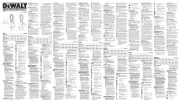
23 Mei 2025

18 Mei 2023

6 Mei 2023

5 Mei 2023

11 April 2023

6 April 2023

31 Maart 2023

8 Maart 2023

4 Maart 2023

27 Februari 2023
Handleiding Zaklamp
- Milwaukee
- WAGAN
- Neff
- MPOWERD
- Parkside
- Livarno
- Celestron
- Total
- BEKO
- Nitecore
- PNI
- FoxFury
- Anker
- Trelock
- Nite Ize
Nieuwste handleidingen voor Zaklamp

26 Augustus 2025

26 Augustus 2025
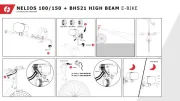
25 Augustus 2025
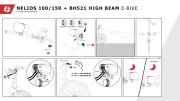
25 Augustus 2025
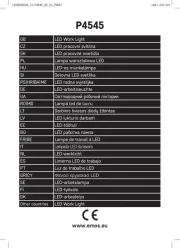
14 Augustus 2025
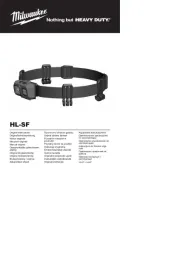
7 Augustus 2025
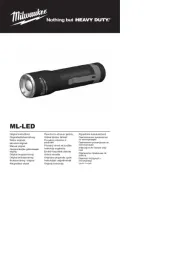
7 Augustus 2025
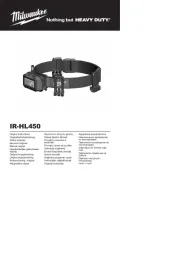
7 Augustus 2025
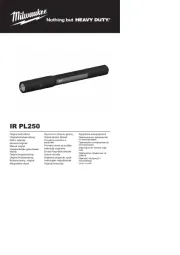
7 Augustus 2025
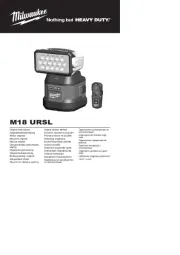
7 Augustus 2025